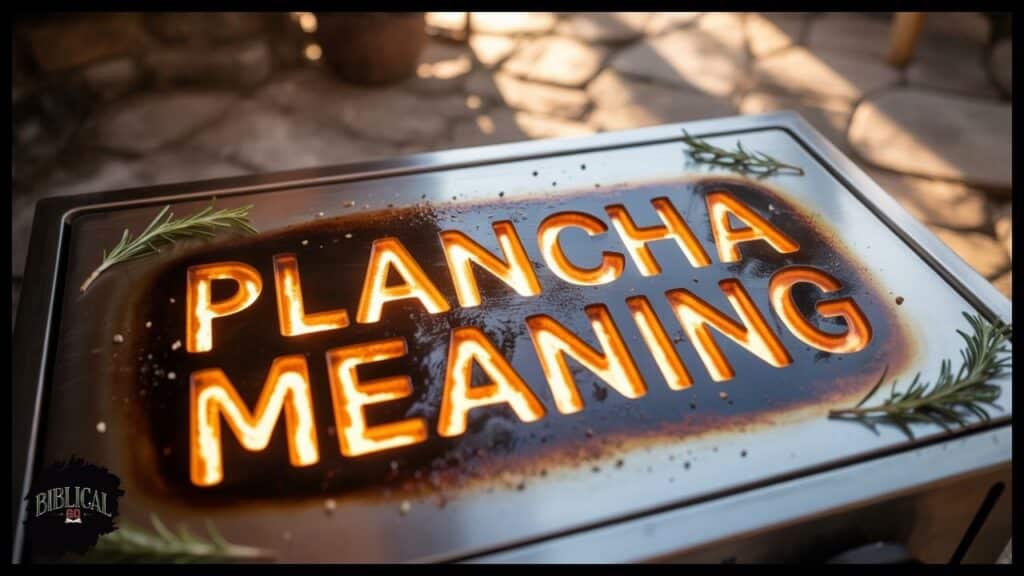Plancha Meaning: Ever walked into a trendy restaurant and seen “a la plancha” on the menu? Or joined a fitness class where the instructor shouts “hold that plancha!”? You’re not alone in wondering what this word actually means.
Plancha has become one of those fascinating words that crosses cultures and contexts. It’s popped up everywhere from high-end steakhouses to your local gym. But here’s the thing its plancha meaning changes dramatically depending on where you hear it.
This comprehensive guide breaks down everything you need to know about plancha definition and usage in 2025. Whether you’re trying to define plancha for cooking, fitness, or casual conversation, we’ve got you covered.
What Does “Plancha” Actually Mean? (The Foundation)
Let’s start with the basics. Plancha comes from Spanish, where its literal meaning is “plate” or “flat surface.” Think of it as describing anything that’s flat, smooth, and typically used for a specific purpose.
The word’s etymology traces back to the Latin “planca,” meaning a flat piece of wood or metal. Over centuries, Spanish speakers adapted it to describe various flat objects and surfaces.
Here’s where it gets interesting: plancha exhibits classic polysemy one word with multiple related meanings. The connection? They all involve flat surfaces doing specific jobs.
Core meanings include:
- Household iron (for clothes)
- Cooking griddle or flat grill
- Exercise plank position
- Casual term for lying flat
The contextual meaning depends entirely on the situation. A chef talking about plancha means something completely different from a fitness trainer using the same word.
The Kitchen Revolution: Plancha as Culinary Game-Changer
A la plancha has revolutionized restaurant menus worldwide. This cooking method involves preparing food on a flat, heated metal surface think of it as Spanish-style griddle cooking.
Traditional plancha cooking uses a thick, flat piece of cast iron or steel heated to high temperatures. Unlike regular grilling with bars, plancha creates even heat distribution across the entire surface.
Key characteristics of plancha cooking:
- Temperatures reach 400-500°F
- Creates beautiful sear marks
- Retains food’s natural juices
- Allows for precise temperature control
- Works with multiple ingredients simultaneously
Popular plancha dishes in 2025:
- Gambas a la plancha (grilled shrimp)
- Pollo a la plancha (grilled chicken)
- Verduras a la plancha (grilled vegetables)
- Carne a la plancha (grilled meat)
Restaurant trends show plancha cooking gaining massive popularity. High-end establishments use it because it delivers restaurant-quality results with impressive visual appeal.
The equipment itself varies significantly:
| Type | Material | Best For | Price Range |
|---|---|---|---|
| Cast Iron Plancha | Cast iron | Home use, small portions | $50-200 |
| Steel Plancha | Carbon steel | Commercial kitchens | $200-800 |
| Electric Plancha | Various metals | Indoor cooking | $100-400 |
| Gas Plancha | Steel/Iron | Outdoor cooking | $300-1500 |
Professional chefs prefer plancha because it combines grilling benefits with precise control. The flat surface means no food falls through grates, and cleanup becomes much easier.
Fitness World Adoption: When Plancha Became Your Core’s Best Friend
Spanish-speaking fitness communities introduced “plancha” as their term for what English speakers call “plank.” The crossover happened naturally both words describe the same flat, rigid position.
Plancha exercise fundamentally means holding your body in a straight line, supported by your forearms and toes. Your core muscles work overtime to maintain this flat position hence the name connection.
Domain-specific language in fitness often varies by region. In Latin American gyms, you’ll hear “hacer la plancha” instead of “do a plank.”
Plancha variations include:
- Standard plancha (basic forearm plank)
- Plancha lateral (side plank)
- Plancha con movimiento (dynamic plank)
- Plancha alta (high plank)
Core strength benefits from plancha exercises are substantial:
- Improves endurance in stabilizing muscles
- Builds functional strength for daily activities
- Reduces lower back pain risk
- Enhances posture and spinal alignment
- Develops mind-muscle connection
Fitness trainers increasingly use “plancha” because it sounds more dynamic than “plank.” The Spanish term carries energy that motivates clients during challenging core plank sessions.
Progression timeline for plancha mastery:
- Week 1-2: Hold for 15-20 seconds
- Week 3-4: Build to 30-45 seconds
- Month 2: Achieve 60-90 seconds
- Month 3+: Add variations and movements
Regional Variations That’ll Surprise You
Cultural semantics reveals fascinating differences in plancha usage across Spanish-speaking regions.
Mexico: “Plancha” primarily means household iron. Mexican families use “hacer la plancha” when talking about ironing clothes. The colloquial language stays close to the original household meaning.
Argentina: Street food culture embraces plancha cooking extensively. Argentine parrillas (grills) often feature plancha sections for cooking choripán and other specialties. The term also appears in casual conversation as “hacer la plancha” meaning to relax or sunbathe.
Spain: Traditional cooking heritage runs deep with plancha usage. Spanish tapas bars perfected iron plate cooking centuries ago. Regional variations include “plancha andaluza” and “plancha catalana” styles.
Latin America broadly: Code-switching between Spanish and English creates interesting hybrid usage. Bilingual speakers might say “plancha workout” or “plancha cooking” in English conversations.
Sociolinguistic variation shows generational differences too. Younger Spanish speakers readily adopt fitness-related plancha usage, while older generations stick to household meanings.
Beyond the Basics: Unexpected Plancha Applications
Lexical ambiguity extends plancha into surprising territories beyond cooking and fitness.
Beauty industry: Hair straightening tools called “plancha para el pelo” (hair iron) represent another flat-surface application. Professional salons distinguish between regular irons and specialized plancha tools.
Industrial uses: Metal fabrication employs plancha terminology for flat steel sheets and plates. Construction workers and welders use “plancha de acero” (steel plate) in technical specifications.
Architecture: Modern design incorporates “plancha” concepts in flat surface elements. Architects specify “plancha de concreto” (concrete slabs) and similar flat structural components.
Marine terminology: Boat builders refer to deck plating as “plancha” in Spanish-speaking maritime communities. The term describes flat metal sheets forming vessel surfaces.
These applications show how semantic shift occurs naturally. The core concept flat surface with specific function remains consistent across different domains.
Context Clues: Reading the Room When Someone Says “Plancha”
Pragmatics teaches us that understanding plancha requires reading situational cues carefully.
Visual environment provides major hints:
- Kitchen setting = cooking context
- Gym environment = exercise meaning
- Household laundry area = ironing reference
- Restaurant menu = culinary preparation
Conversational markers also signal meaning:
- “Vamos a hacer…” suggests exercise
- “Cocinado a la…” indicates cooking method
- “Necesito usar la…” implies household iron
- “Me gusta hacer la…” could mean relaxing
Age demographics influence usage patterns significantly. Younger speakers (18-35) lean toward fitness and culinary meanings. Older generations (50+) default to household iron context.
Tone and register matter tremendously:
- Formal business settings favor culinary usage
- Informal conversations allow multiple meanings
- Casual beach talk often means sunbathing flat
Language disambiguation becomes easier with practice. Listen for surrounding words that clarify intent.
Common Mix-Ups That Cause Confusion
Lexical ambiguity creates predictable confusion patterns that trip up Spanish learners and native speakers alike.
Restaurant ordering mishaps happen frequently. Customers hear “plancha” and think “iron” instead of cooking method. This confusion leads to awkward ordering situations and disappointed diners.
Gym instruction misunderstandings occur when bilingual fitness classes mix terminology. New students might not connect “plancha” with “plank,” causing exercise confusion.
Online recipe translation errors plague cooking websites. Automated translation tools struggle with contextual meaning, producing nonsensical results like “iron the chicken” instead of “cook on the plancha.”
Social media hashtag confusion multiplies the problem. Fitness influencers using #plancha might attract cooking enthusiasts, while food bloggers draw exercise fans.
Common mistake patterns:
- Assuming one meaning applies universally
- Ignoring cultural semantics in translation
- Missing tone-dependent interpretation cues
- Overlooking regional usage preferences
Prevention strategies include:
- Always consider the setting and context
- Ask for clarification when uncertain
- Learn regional preferences for your area
- Practice synonym substitution skills
Mastering Plancha Usage: Practical Applications for 2025
Term normalization helps you choose the right plancha meaning for each situation.
Professional settings require precision:
- Restaurants: Always specify “a la plancha” for cooking
- Gyms: Use “plancha” or “plank” based on client preference
- Retail: Clarify household iron vs. cooking equipment
- Translation: Consider target audience and context
Cultural competency demands understanding your audience. Latin cultures appreciate authentic Spanish usage, while mixed audiences might need English explanations.
Regional sensitivity considerations include:
- Matching local usage patterns
- Respecting traditional meanings
- Avoiding assumptions about understanding
- Providing context when switching meanings
Future trends suggest:
- Increased fitness industry adoption
- Growing culinary mainstream acceptance
- More bilingual code-switching in conversation
- Enhanced digital translation accuracy
Best practices for 2025:
- Lead with context clues in conversation
- Use descriptive phrases alongside “plancha”
- Respect regional preferences and traditions
- Stay updated on evolving usage patterns
Communication strategies:
- Business meetings: Clarify meaning immediately
- Vacation talk: Embrace multiple interpretations
- Marketing language: Target specific contexts
- Instructional language: Define terms clearly
The Bottom Line: Why Understanding Plancha Matters Now
Globalization of food and fitness cultures makes plancha understanding essential for modern communication.
Professional advantages abound in hospitality and fitness industries. Servers who understand “a la plancha” provide better customer service. Trainers using “plancha” connect with diverse clientele more effectively.
Cultural competency in diverse communities requires multilingual sensitivity. Understanding plancha usage shows respect for Spanish-English translation nuances and cultural heritage.
The word’s versatility reflects broader language evolution patterns. Idiomatic expressions cross borders through immigration, media, and global business connections.
Key takeaways:
- Context always determines plancha definition
- Regional variations require local knowledge
- Professional settings demand precision
- Cultural sensitivity enhances communication
Future outlook for plancha usage:
- Continued expansion in English-speaking markets
- Enhanced cross-cultural communication importance
- Growing mainstream acceptance across contexts
- Increased bilingual integration in various industries
Understanding plancha isn’t just about vocabulary it’s about navigating our interconnected world with cultural intelligence and practical knowledge. Whether you’re ordering dinner, hitting the gym, or having casual conversation, knowing these distinctions makes you a more effective communicator.
The beauty of plancha lies in its adaptability. One word connects cooking traditions, fitness routines, household tasks, and casual relaxation. That’s the power of language evolution in action simple concepts expanding to meet complex communication needs.
Master plancha usage, and you’ll navigate Spanish-influenced contexts with confidence and cultural awareness that others will notice and appreciate.
FAQs
What’s the Real Plancha Meaning When My Trainer Yells It During Workouts?
Your trainer isn’t speaking gibberish! The plancha meaning in fitness contexts refers to the plank exercise position. Spanish-speaking fitness communities use “plancha” because it literally describes holding your body flat like a plate or iron. When your trainer says “hold that plancha,” they want you maintaining that rigid, flat position that challenges your core muscles. It’s the same exercise as a plank just with more cultural flair and energy that motivates you to push through the burn.
How Does Plancha Meaning Change Between My Kitchen and My Gym?
The plancha meaning shifts dramatically based on location! In your kitchen, “a la plancha” means cooking on a flat, heated surface think Spanish-style griddle cooking that creates amazing sears on meat and vegetables. In your gym, “plancha” means that challenging core exercise where you hold your body straight as a board. Both meanings connect to the original Spanish concept of “flat surface,” but the application couldn’t be more different. Context is everything with this versatile word.
Why Don’t Translation Apps Get Plancha Meaning Right?
Translation apps struggle with plancha meaning because it’s a perfect example of polysemy one word with multiple related meanings. Basic translation software can’t read context clues like humans do. When you search “plancha recipe,” the app might translate it as “iron recipe” instead of recognizing the cooking context. The artificial intelligence lacks cultural knowledge and situational awareness that determines whether plancha means household iron, cooking griddle, or exercise position. Always double-check translations for context-dependent words like plancha.
Is Plancha Meaning Different in Mexico vs. Spain vs. Argentina?
Absolutely! Plancha meaning varies significantly across Spanish-speaking regions due to cultural preferences and local traditions. In Mexico, people primarily use plancha for household irons and clothes pressing. Spain heavily emphasizes the culinary meaning their tapas culture perfected “a la plancha” cooking centuries ago. Argentina embraces both cooking and casual meanings, where “hacer la plancha” can mean grilling food or relaxing flat in the sun. These regional differences reflect how language evolves within specific cultural contexts.
What’s the Trendy Plancha Meaning That’s Taking Over Restaurant Menus in 2025?
The hottest plancha meaning in 2025 restaurant scenes is “a la plancha” cooking Spanish-style flat-surface grilling that’s revolutionizing how chefs prepare food. Unlike traditional grilling with grates, plancha cooking uses a thick, flat metal surface heated to 400-500°F. This method creates perfect sears, retains natural juices, and allows precise temperature control. High-end restaurants love it because plancha delivers stunning visual results with superior flavor. When you see “gambas a la plancha” or “pollo a la plancha” on menus, you’re experiencing this culinary trend that’s conquering kitchens worldwide.
Read more knowledgeable blogs on Biblical Go

Piper McMillan is a devoted writer and Bible enthusiast, offering insightful guides on Bible verses. Her blog provides practical interpretations and reflections, helping readers deepen their faith and understanding of Scripture through accessible and inspiring content.



